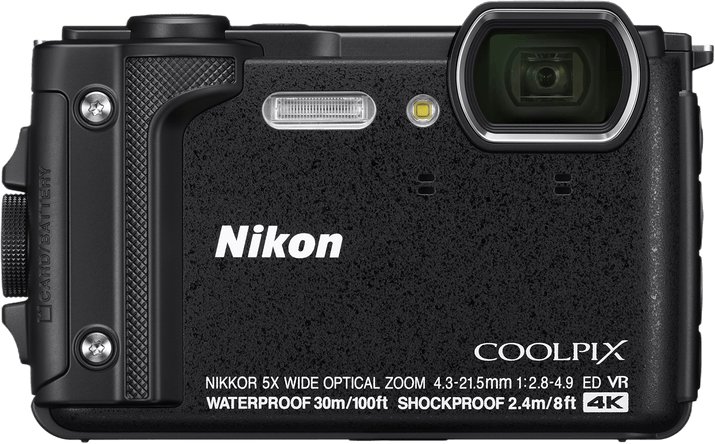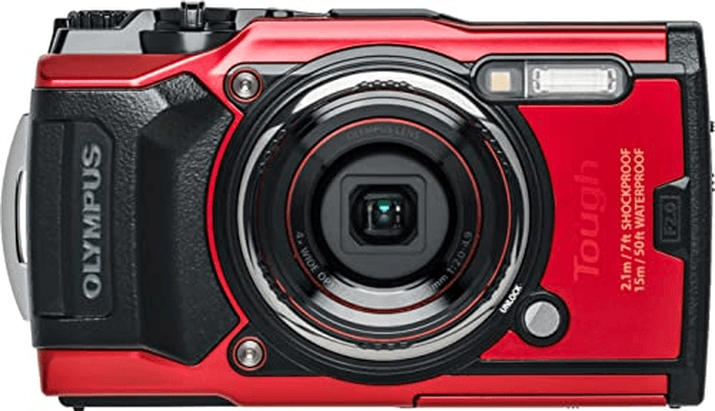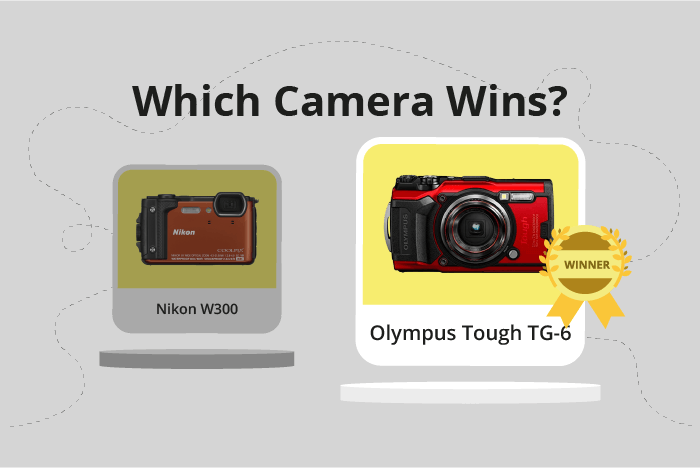Nikon W300 vs Olympus Tough TG-6 Comparison
Nikon W300

Olympus Tough TG-6

The Olympus Tough TG-6 wins with a score of 59/100, while the Nikon W300 trails behind at 54/100. Both cameras are compact and were released within two years of each other, with the TG-6 in 2019 and the W300 in 2017. They have similar dimensions, but the TG-6 is slightly heavier at 253g compared to the W300’s 231g.
The TG-6’s higher score indicates its superior performance and features. However, the W300 has its advantages, such as a lower launch price of $389 compared to the TG-6’s $450. This makes the W300 a more budget-friendly option.
Considering their specifications and scores, the Olympus Tough TG-6 is the better choice for those seeking a higher-performing compact camera, while the Nikon W300 suits those looking for a more affordable option.
Nikon W300 vs Olympus Tough TG-6 Overview and Optics
The Nikon W300 and Olympus Tough TG-6 both scored 52/100 in our optics comparison, indicating that they have similar optical performance. Both cameras share common specifications, such as a 1/2.3″ CMOS sensor, image stabilisation, and a fixed lens mount that prevents lens changes.
The Nikon W300 has a slight edge in image quality due to its higher megapixel count of 16, compared to the Olympus Tough TG-6’s 12 megapixels. This allows the Nikon W300 to capture more detail in images. Additionally, the Nikon W300 has a higher DXOMARK sensor score of 72, compared to 70 for the Olympus Tough TG-6, suggesting better overall sensor performance.
However, the Olympus Tough TG-6 excels in shooting speed with an impressive 20 frames per second, compared to the Nikon W300’s 7 frames per second. This makes the Olympus Tough TG-6 better suited for capturing fast-moving subjects or action scenes. Moreover, the Olympus Tough TG-6 is equipped with the TruePic VIII processor, which provides faster image processing and better performance in low-light conditions.
In terms of optics, the Nikon W300 and Olympus Tough TG-6 offer similar performance, with the Nikon W300 having a slight advantage in image quality due to its higher megapixel count and better sensor score. On the other hand, the Olympus Tough TG-6 stands out for its fast shooting speed and better image processing. Ultimately, the choice between these two cameras will depend on the specific needs of the user, with the Nikon W300 being more suitable for capturing detailed images and the Olympus Tough TG-6 excelling in action photography.
Nikon W300 vs Olympus Tough TG-6 Video Performance
The Nikon W300 outperforms the Olympus Tough TG-6 in terms of video capabilities, scoring 91/100 compared to the TG-6’s score of 83/100. Both cameras share some common specifications, such as the maximum video resolution of 4K and video dimensions of 3840 x 2160. Additionally, they both have built-in time-lapse functionality.
The Nikon W300’s superior video performance is due to its higher maximum video frame rate of 120fps, which is twice as fast as the Olympus Tough TG-6’s 60fps. This higher frame rate allows the W300 to capture smoother, more detailed slow-motion footage, making it a better choice for those who prioritize video quality in their camera selection.
On the other hand, the Olympus Tough TG-6 is not completely outclassed in the video department. While it has a lower maximum frame rate, it still provides 4K video resolution and time-lapse functionality. For users who do not require the higher frame rate for slow-motion footage, the TG-6 is still a solid option for capturing high-quality video.
When comparing the video capabilities of the Nikon W300 and the Olympus Tough TG-6, it is clear that the W300 is the better choice for those who prioritize video quality, offering a higher frame rate for smoother slow-motion footage. However, the Olympus Tough TG-6 remains a viable option for users who do not require the extra frame rate and still want to capture 4K video and time-lapse content.
Nikon W300 vs Olympus Tough TG-6 Features and Benefits
The Olympus Tough TG-6 surpasses the Nikon W300 in features, scoring 83 out of 100 compared to the W300’s score of 68. Both cameras share several specifications, including a 3-inch screen, GPS, WiFi, and Bluetooth capabilities. However, the TG-6 has certain advantages that contribute to its higher score.
The Olympus TG-6 boasts a higher screen resolution of 1,040,000 dots, while the Nikon W300 has a resolution of 921,000 dots. This difference results in a clearer and sharper display on the TG-6, enhancing the user’s experience when reviewing images. The TG-6 also has a touchscreen, which the W300 lacks. Touchscreen functionality allows for a more intuitive and efficient operation, making the TG-6 more user-friendly.
Despite its lower score, the Nikon W300 still has commendable features. Both cameras lack a flip screen, which is not necessarily a disadvantage but rather a shared specification. The W300’s features are still satisfactory for many photography enthusiasts, and it may excel in other areas not discussed in this comparison.
Considering the features and specifications, the Olympus Tough TG-6 is the superior camera in this comparison. Its higher screen resolution and touchscreen functionality contribute to its higher score and make it a more appealing option for users seeking these specific features. The Nikon W300, while scoring lower, remains a viable option for those who prioritize other aspects of camera performance.
Nikon W300 vs Olympus Tough TG-6 Storage and Battery
The Olympus Tough TG-6 triumphs over the Nikon W300 in storage and battery with a score of 35 points, compared to the W300’s 16 points. Both cameras share similarities in storage, as they have one memory card slot each and accept SD, SDHC, and SDXC cards with UHS-I compatibility.
The TG-6 outperforms the W300 in battery life, offering 340 shots per charge compared to the W300’s 280 shots. Additionally, the TG-6 uses a LI-92B battery type and supports USB charging, making it more convenient for on-the-go charging.
On the other hand, the W300 has a unique advantage in storage by offering internal storage, which the TG-6 lacks. However, this advantage does not compensate for its inferior battery life and lack of USB charging.
Ultimately, the Olympus Tough TG-6 proves to be the better choice in terms of storage and battery performance, while the Nikon W300 falls short in these aspects.
Nikon W300 vs Olympus Tough TG-6 – Our Verdict
Are you still undecided about which camera is right for you? Have a look at these popular comparisons that feature the Nikon W300 or the Olympus Tough TG-6:

